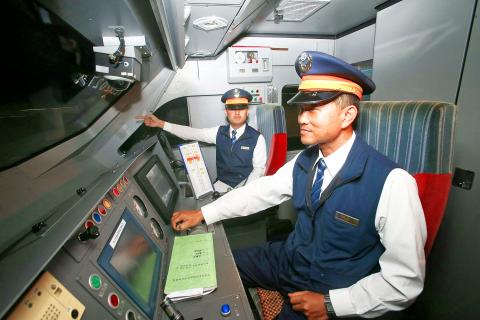The Taiwan Railways Administration (TRA) yesterday said that 228 apprentices and 10 driving assistants have been dispatched to assist drivers of express train services to promote passenger safety.
The initiative is part of reforms at the TRA that Minister of Transportation and Communications Wu Hong-mo (吳宏謀) announced on Monday after a Puyuma Express train derailment on Oct. 21 that killed 18 passengers and injured 215.
Preliminary findings by an Executive Yuan investigative team showed that the train driver, surnamed You (尤), was communicating with a train dispatcher and an inspector about a technical problem he was having for 43 minutes.

Photo courtesy of the Taiwan Railways Administration
The accident shows the risk of having only one driver on board, prompting the Ministry of Transportation and Communications’ (MOTC) decision to have two drivers operating each train.
MOTC Deputy Minister Chi Wen-chung (祁文中) yesterday morning visited the TRA to see how it was implementing the new measure.
The TRA has 18 Puyuma Express and eight Taroko Express train services.
To implement the two-driver policy, the apprentice drivers and driving assistants yesterday started assisting the drivers of the two express train services, the TRA said.
“We will see if we need to continue implementing the two-driver policy after we have ascertained that the ATPs [automatic train protection] can function reliably,” Chi said.
The TRA has six types of trains: diesel-electric locomotives, electric locomotives, diesel hydraulic locomotives, push-pull electric locomotives, steam locomotives and electric multiple units.
It takes about 23 months to train a driver to operate one type of train, and another month of training to be able to operate a different type of train, the TRA said.
The TRA Train Drivers’ Association said that it used to be a TRA policy to have two drivers on board.
“However, as the agency began acquiring new trains and safety equipment, it began experimenting with having only one driver operate the train,” the association said.
The group said it has been urging the TRA to return to a two-driver policy for all trains after the collision at Dali Train Station (大里) in Yilan County in 2007, but the agency has rejected its proposal.
Meanwhile, the Society of Railway and National Planning said that the task force entrusted to conduct a comprehensive evaluation of the TRA should take an in-depth look at the issues facing the agency.
“We absolutely understand the importance and necessity of having such a task force, but the task force should give the TRA a vision as well as strategies to achieve them before talking about reforms. It should also review how transport policies in the past have affected the TRA’s operations,” the society said.
Members of the task force should feel free to talk about what they think the problem is without fear of being punished, and all stakeholders must strive to reach a consensus on measures that the task force proposes to improve the agency, the society said.
Finally, the task force must list specific steps and timeline that the TRA must follow, which should help the agency reorganize its personnel structure, recruit workers and make budget plans, it said.

Auckland rang in 2026 with a downtown fireworks display launched from New Zealand’s tallest structure, Sky Tower, making it the first major city to greet the new year at a celebration dampened by rain, while crowds in Taipei braved the elements to watch Taipei 101’s display. South Pacific countries are the first to bid farewell to 2025. Clocks struck midnight in Auckland, with a population of 1.7 million, 18 hours before the famous ball was to drop in New York’s Times Square. The five-minute display involved 3,500 fireworks launched from the 240m Sky Tower. Smaller community events were canceled across New Zealand’s

The Ministry of Foreign Affairs (MOFA) yesterday said it is closely monitoring developments in Venezuela, and would continue to cooperate with democratic allies and work together for regional and global security, stability, and prosperity. The remarks came after the US on Saturday launched a series of airstrikes in Venezuela and kidnapped Venezuelan President Nicolas Maduro, who was later flown to New York along with his wife. The pair face US charges related to drug trafficking and alleged cooperation with gangs designated as terrorist organizations. Maduro has denied the allegations. The ministry said that it is closely monitoring the political and economic situation

‘SLICING METHOD’: In the event of a blockade, the China Coast Guard would intercept Taiwanese ships while its navy would seek to deter foreign intervention China’s military drills around Taiwan this week signaled potential strategies to cut the nation off from energy supplies and foreign military assistance, a US think tank report said. The Chinese People’s Liberation Army (PLA) conducted what it called “Justice Mission 2025” exercises from Monday to Tuesday in five maritime zones and airspace around Taiwan, calling them a warning to “Taiwanese independence” forces. In a report released on Wednesday, the Institute for the Study of War said the exercises effectively simulated blocking shipping routes to major port cities, including Kaohsiung, Keelung and Hualien. Taiwan would be highly vulnerable under such a blockade, because it

UNRELENTING: China attempted cyberattacks on Taiwan’s critical infrastructure 2.63 million times per day last year, up from 1.23 million in 2023, the NSB said China’s cyberarmy has long engaged in cyberattacks against Taiwan’s critical infrastructure, employing diverse and evolving tactics, the National Security Bureau (NSB) said yesterday, adding that cyberattacks on critical energy infrastructure last year increased 10-fold compared with the previous year. The NSB yesterday released a report titled Analysis on China’s Cyber Threats to Taiwan’s Critical Infrastructure in 2025, outlining the number of cyberattacks, major tactics and hacker groups. Taiwan’s national intelligence community identified a large number of cybersecurity incidents last year, the bureau said in a statement. China’s cyberarmy last year launched an average of 2.63 million intrusion attempts per day targeting Taiwan’s critical